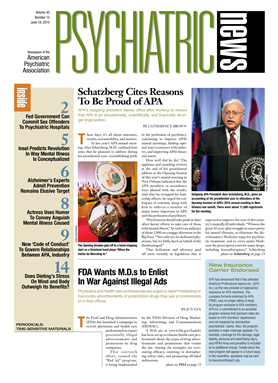Stating that all medical specialties have a stake in the emerging DSM-5, Darrel Regier, M.D., M.P.H., and David Kupfer, M.D., outlined principal issues in the development of the manual in a special theme issue of the Journal of the American Medical Association on mental illness.
They noted that when development of the new manual began in 1999, an overriding concern was how to address issues that emerged from research on mental illness in the previous 25 years. “Such concerns included the potential for adding dimensional assessments to disorders, exploring the option of separating diagnoses from their associated disabilities, examining the expressions of all disorders across the entire life span, and the need to address differences in mental disorder expression as conditioned by gender and cultural characteristics,” they said.
Progress since that time has yielded “a clear set of priorities for DSM-5.” These include evaluating the consequences of continuing to use the hierarchical “pure” diagnostic categories now in place and reified since DSM-III, the high rates of co-occurring diagnoses identified by these criteria in individuals with at least one mental disorder, the frequent use of the “not otherwise specified” designations for patients who do not fit any of the criteria, and the heterogeneous mix of conditions within current diagnostic boundaries.
Kupfer and Regier also highlighted the following questions that will be emphasized in forthcoming stages of the diagnostic manual's revision:
•.
How can the clinical assessments of mental disorders be improved?
•.
How can DSM-5 better address the interface between psychiatry and general medicine?
•.
Can clinicians move away from reliance on signs and symptoms to classify disorders?
•.
What can be done to make DSM-5 more flexible so it can easily incorporate advances in neuroscience and behavioral science?
Another issue that they indicated will be part of the DSM-5 discussion is how the manual should align with the international community classification. “The timelines of publishing DSM-5 and the U.S. introduction of the ICD, Tenth Revision, Clinical Modification in 2013 coincide well and will offer an invaluable opportunity to ensure integration of DSM-5 with the rest of the U.S. medical classification changes,” Regier and Kupfer said. “Likewise, a cross-national alignment of diagnoses will be facilitated when ICD-11 is adopted by the [World Health Organization] in 2014. Accordingly, DSM-5 will be of value for all of medicine.”
